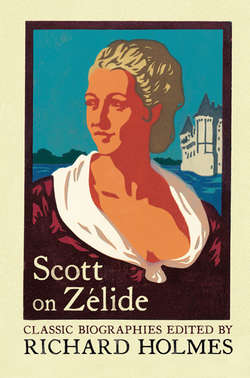Читать книгу Scott on Zélide: Portrait of Zélide by Geoffrey Scott - Richard Holmes - Страница 11
7
ОглавлениеFar from softening or sentimentalizing the texture of the biography, this secret shimmer of subjectivity gives it an almost unnatural sharpness and stylistic brightness. From the opening Scott makes brilliant metaphoric use of the pastel portrait of Zélide by George de la Tour, and the contrasting monotonies of Dutch landscape (and society) stretching behind her. The whole book has a strong visual sense, and Scott continually presents Zélide’s moods in terms of beautifully conjured landscapes or interiors, a series of Dutch still-lives.
Yet just as he planned, he moves the narrative forward at a dazzling pace, compressing and summarizing the story, foreshortening perspective, and playing off the immobility of Zélide’s life at Zuylen and Colombier against the frantic gyrations of Boswell or Constant. The arrival and departure of carriages forms a choric motif, reaching its apotheosis in the fatal carriage of Madame de Staël. Scott is so enraptured by Constant’s peripatetic adventures in England (chapter 7), and later in Germany (chapter 9), that they almost threaten to leave Zélide entirely behind.
He wonderfully catches minor characters, by impish anecdote and ironic aside. His handling of the inquisitive Pastor Chaillet with his miniscule handwriting, and the well-meaning and foolish Madame Huber at Le Pontet, are masterly. While Constant’s animal-obsessed German princess, Wilhelmina, is immortalized in a single footnote.
Scott’s attitude to Zélide herself is complex, shifting, and unexpectedly contradictory. From the outset he has pronounced her life a tragedy and a failure, yet he cannot prevent himself treating it gallantly, humorously and even at times romantically. In fact one suspects that Geoffrey Scott is always in two minds about Zélide, and part of him is always in love with her. The most beautiful and memorable images in the book are always dedicated to her. ‘So Zélide lay, lost to the world, like a bright pebble on the floor of the Lake of Neufchâtel.’
It is true that he ignores or distorts several elements in her story. He underplays the significance of her published writing (apart from its autobiographical aspect), and fails to see the importance of the later work for the feminist canon, notably the brilliantly plotted moral fable, Three Women. It is difficult to imagine that Zélide was the author of twelve short novels, twenty-six plays, several libretti for opera, and much harpsichord music as well. Nor does he connect her extensive output with younger English writers addressing similar themes, like Mary Wollstonecraft, Amelia Opie, or Fanny Burney. But this, perhaps, is a failure of historical rather than biographical perspective.
More problematically, Scott does not seem to sympathize – or should one say empathize – with what Zélide called the difficulties of having a woman’s ‘susceptible body’. He does not seem to allow sufficiently for the devastating effect of her physical inability to have children with M de Charrière, or relate this to her clandestine affair with the handsome (but still unknown) young man in Geneva sometime in 1784–5. Zélide was then in her mid-forties, feeling life slipping away, and was perhaps making her one, last serious attempt to act like Ninon de Lenclos. As Benjamin Constant pointed out, this adulterous episode, perhaps Zélide’s only real adulterous episode, produced her masterpiece, Caliste.
Above all perhaps, Geoffrey Scott undervalues the happiness that her last circle of young women friends and protegées brought her after 1790, when she was fifty. They included the flirtatious and incorrigibly pregnant maid Henriette Monarchon; the handsome and talented Henriette l’Hardy (who became her literary executor); the dazzlingly beautiful Isabelle de Gélieu; the clever sophisticated Caroline de Sandoz-Rollin; and the ‘wild, gorgeous, defiant’ sixteen-year-old Suzette du Pasquier.
These produced Zélide’s own kind of salon des dames at Colombier, and exchanges of letters, poems, and confidences quite as full as her masculine ones. Such a circle was, after all, part of Zélide’s original plan to consecrate her life to friendship as well as love. And who is to say that some of these young women, with their new independent ways, did not bring Zélide love as well as friendship?
